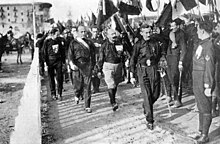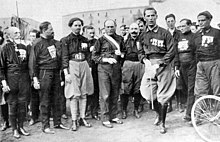March on Rome
You can help expand this article with text translated from the corresponding article in Italian. (January 2024) Click [show] for important translation instructions.
|
| March on Rome | |||||||||
|---|---|---|---|---|---|---|---|---|---|
| Part of Civil unrest in Italy | |||||||||
  Benito Mussolini and his Blackshirts during the March | |||||||||
| |||||||||
| Belligerents | |||||||||
|
| |||||||||
| Commanders and leaders | |||||||||
|
|
| ||||||||
| Political support | |||||||||
|
Communists |
| ||||||||
The March on Rome (
Background
In March 1919, Benito Mussolini founded the first
During the "two red years", there were numerous strikes, protests against rises in the cost of living, occupations of factories and land by industrial workers or agricultural laborers, and other types of clashes between socialists on one side and landowners and business owners on the other side.[4] The government tried to play the role of neutral mediator, which dissatisfied both sides.[5] Local elites felt themselves vulnerable and began to establish an alliance with the small Fascist movement, which contained many veterans of World War I and had a reputation for violence, in the hope of using Fascist paramilitary squads to destroy socialist organizations.[6]
Since 1919, Fascist militias, known as
Local elections in 1920 were won by the socialists in many towns, cities and villages across Italy, and in response Fascist militias attacked union organizers and municipal administrators, making it difficult for local governments to function.[7] A local deputy from the town of Budrio sent a telegram to the prime minister in October 1921 to report that the Fascists had effectively taken over, that "unions and socialist clubs [were] ordered to dissolve themselves within 48 hours or face physical destruction" and that the "life of the town is paralysed, authorities impotent".[8] Similar situations also occurred in other towns across Northern and Central Italy from 1920 to 1922.[9] The police repeatedly failed to intervene against Fascist violence, and in some cases police officers openly supported the Fascists and supplied them with weapons.[10]
In the
After a few weeks, Mussolini withdrew his support for Giolitti and his
In August 1922, an anti-fascist general strike was organized throughout the country by the socialists. Mussolini declared that the Fascists would suppress the strike themselves if the government did not immediately intervene to stop it, which enabled him to position the Fascist Party as a defender of law and order.[12] On 2 August, in Ancona, Fascist squads moved in from the countryside and razed all buildings occupied by socialists.[12] This was then repeated in Genoa and other cities.[12]
In Milan, on 3 and 4 August, there was street fighting between socialists and fascists; the fascists destroyed the printing presses of the socialist newspaper Avanti! and burned its buildings.[12] Then, with the support of local business owners, they took over local government and expelled the elected socialist administration from the town hall.[12]
The Italian national government in Rome did nothing to react to these developments, and its inaction prompted Mussolini to begin planning a march on Rome.[12] From their new power base in Milan, the Fascists gathered the financial support of large companies who were determined to fight against "strikes, bolshevism and nationalization".[13] A delegation from the General Confederation of Italian Industry met with Mussolini two days before the March on Rome.[14] Also a few days before the march, Mussolini consulted with the U.S. Ambassador Richard Washburn Child about whether the U.S. government would object to Fascist participation in a future Italian government and Child gave him American support. When Mussolini learned that Prime Minister Luigi Facta had given Gabriele D'Annunzio the mission to organize a large demonstration on 4 November 1922 to celebrate the national victory during the war, he decided to immediately implement the March.[15]
March

On 24 October 1922, Mussolini declared in front of 60,000 militants at a Fascist rally in
On 26 October, the former Prime Minister
On the morning of 28 October, in Milan, Mussolini received a delegation of supportive industrialists at the Il Popolo d'Italia headquarters who urgently requested him to find a compromise with Antonio Salandra. Mussolini was then proposed to rule alongside Salandra, however he refused.[20][21] Following an analysis of the footage of the time with the facial recognition technique, the presence alongside Mussolini of Raoul Vittorio Palermi, Grand Master of the Gran Loggia d'Italia, was also ascertained.[22][23]
On 30 October, the King handed power to Mussolini, who was supported by the military, the business class, and the right wing.[24]

The march itself was composed of fewer than 30,000 men, but the King in part feared a
Back in 1922, in the aftermath of the March on Rome, Mussolini pretended to be willing to take a junior ministry in a Giolitti or Salandra cabinet, but then demanded the presidency of the Council of Ministers.[29] Fearing a conflict with the fascists, the ruling class thus handed power to Mussolini, who went on to install the dictatorship after the 10 June 1924 assassination of Giacomo Matteotti – who had finished writing The Fascisti Exposed: A Year of Fascist Domination – executed by Amerigo Dumini, accused of being the leader of the "Italian Ceka", though there is no evidence for such an organization existing.
Other participants
- Giacomo Acerbo
- Italo Balbo
- Roberto Farinacci
- Giovanni Giuriati
- Serafino Mazzolini
- Ettore Muti
- Aurelio Padovani
- Alessandro Pavolini
- Carlo Scorza
- Achille Starace
- Harukichi Shimoi
Commemorative medal

At the end of 1923, participants in the march received authorization to wear the Commemorative Medal of the March on Rome (Italian: Medaglia commemorativa della Marcia su Roma). In a series of royal decrees between 1926 and 1938, the Kingdom of Italy expanded eligibility for the medal until by mid-1938 all members of the Blackshirts and the Italian Armed Forces were authorized to wear it.[30][31][32]
See also
- Beer Hall Putsch (similar action by the Nazi Party inspired by the March on Rome)
- Fascist and anti-Fascist violence in Italy (1919–26)
- Peasant March
- Red Shirts (Mexico)
- Red Shirts (Thailand), Thailand
- March of the Iron Will
- Joraku
References
- Carsten, Francis Ludwig (1982). The Rise of Fascism. University of California Press.
- Cassells, Alan. Fascist Italy. Arlington Heights, IL: H. Davidson, 1985.
- Gallo, Max. Mussolini's Italy: Twenty Years of the Fascist Era. New York: Macmillan, 1973.
- Leeds, Christpher. Italy under Mussolini. Hove, East Sussex: Wayland, 1988 (1972).
- Chiapello, Duccio. Marcia e contromarcia su Roma. Marcello Soleri e la resa dello Stato liberale. Rome: Aracne, 2012.
- Gentile, Emilio. E fu subito regime. Il fascismo italiano e la marcia su Roma. Rome-Bari: Laterza, 2012.
Notes
- ISBN 978-0-415-55394-0.
- ^ "March on Rome | Italian history". Encyclopedia Britannica. Retrieved 2017-07-25.
- ^ Denis Mack Smith, Modern Italy: A Political History, University of Michigan Press (1997) p. 297
- ^ John Pollard, The Fascist Experience in Italy, London and New York: Routledge, 1998, p. 29
- ^ John Pollard, The Fascist Experience in Italy, London and New York: Routledge, 1998, p. 30
- ^ John Pollard, The Fascist Experience in Italy, London and New York: Routledge, 1998, p. 31
- ^ John Pollard, The Fascist Experience in Italy, London and New York: Routledge, 1998, pp. 31–33
- ^ John Pollard, The Fascist Experience in Italy, London and New York: Routledge, 1998, p. 33
- ^ John Pollard, The Fascist Experience in Italy, London and New York: Routledge, 1998, pp. 33–34
- ^ John Pollard, The Fascist Experience in Italy, London and New York: Routledge, 1998, pp. 41–42
- ^ Charles F. Delzell, edit., Mediterranean Fascism 1919–1945, New York: Walker and Company, 1971, p. 26
- ^ a b c d e f Denis Mack Smith, Modern Italy: A Political History, University of Michigan Press (1997) p. 308
- ^ Denis Mack Smith, Modern Italy: A Political History, University of Michigan Press (1997) p. 313
- ^ Denis Mack Smith, Modern Italy: A Political History, University of Michigan Press (1997) p. 314
- ^ "I "duci rivali": Mussolini e D'Annunzio a confronto" (in Italian). 30 June 2019. Retrieved 23 November 2021.
- ^ Carsten (1982), p.62
- ISBN 0-333-53779-3.
- ^ Chiapello (2012), p.123
- ^ Carsten (1982), p.64
- ^ "La Marcia su Roma e l'avvio del Regime".
- OCLC 469368426.
- ^ "The direction of Freemasonry behind the march on Rome and the rise of fascism" (in Italian). Agenzia Giornalistica Italia. October 28, 2022.
- ^ "The direction of Freemasonry behind the march on Rome and the rise of fascism. Thanks to a facial recognition". Wired. October 28, 2022.
- OCLC 254666529.
- ^ "28 ottobre 1922: è marcia su Roma" (in Italian). 25 October 2013. Retrieved 23 November 2021.
- ^ Carsten (1982), p.76
- ^ T Gianni Toniolo, editor, The Oxford Handbook of the Italian Economy Since Unification, Oxford University Press (2013) p. 58.
- ^ T Gianni Toniolo, editor, The Oxford Handbook of the Italian Economy Since Unification, Oxford University Press (2013) p. 59.
- ISBN 978-0-415-55394-0.
- ^ Royal Decree Number 273 of 31 January 1926, Uso delle decorazioni per il personale militare ("Use of decorations for military personnel"), published in the Gazzetta Ufficiale del Regno d'Italia ("Official Gazette of the Kingdom of Italy") Number 49 of 1 March 1926 (in Italian).
- ^ Royal Decree Number 2485 of 1 November 1928 (in Italian).
- ^ Royal Decree No. 1179 of 15 July 1938 (in Italian).
External links
- Mussolini's March on Rome – Original reports from The Times
- The March on Rome entry at Tiscali reference (archived 7 November 2005)
- Map of Europe and Italian Fascist seizure of power at omniatlas
- Keserich, Charles (1972). "The Fiftieth Year of the "March on Rome": Recent Interpretations of Facism". The History Teacher. 6 (1): 135–142. JSTOR 492632.
- Jensen, Richard Bach (4 July 2021). "Uncanny Precedent: The March on Rome". Terrorism and Political Violence. 33 (5): 903–906. S2CID 236457468.
- Sarti, Roland (April 1968). "Fascism and the Industrial Leadership in Italy before the March on Rome". ILR Review. 21 (3): 400–417. S2CID 154342983.
- Albanese, Giulia (July 2012). "Reconsidering the March on Rome". European History Quarterly. 42 (3): 403–421. S2CID 147015081.
- Ellery, Eloise (1928). "Fascisti Celebrate Sixth Anniversary of March on Rome". Current History. 29 (3): 504–507. S2CID 249814575.
